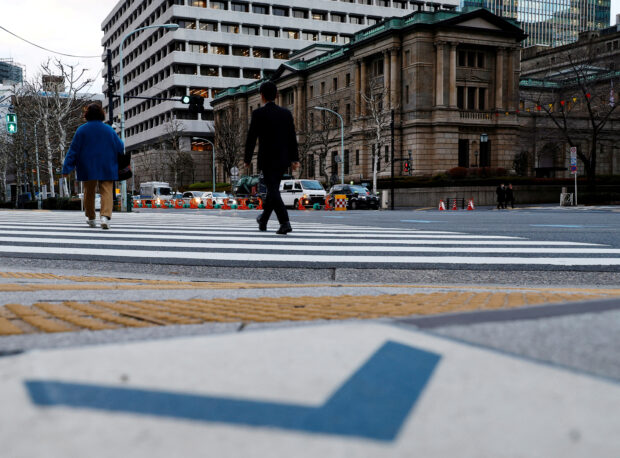
People walk in front of the Bank of Japan building in Tokyo, Japan Jan 23, 2024. REUTERS/Kim Kyung-Hoon/File photo
TOKYO — Bank of Japan board member Hajime Takata said the central bank must consider overhauling its ultra-loose monetary policy, including an exit from negative interest rates and bond yield control.
Measures that should be under consideration include an exit from yield curve control, negative interest rates and a tweak to the BOJ’s commitment to keep expanding its monetary base until inflation stably exceeds 2 percent, he said in a speech on Thursday.
“It’s necessary to consider taking a nimble and flexible response, including on how to exit, or shift gear from the current extremely accommodative monetary policy,” he added.
“While there are some economic uncertainties, I feel that we’re finally seeing prospects for achieving our 2 percent inflation target,” Takata said, pointing to growing signs of change in companies’ long-held practice of forgoing wage and price hikes.
Dollar vs yen
The dollar fell 0.33 percent to 150.21 yen, while the benchmark 10-year government bond rose 1.5 basis point to 0.710 percent after the remarks, which market participants interpreted as signaling a strong chance that an unwinding of ultra-loose policy was imminent.
READ: BOJ to scrap negative interest rates in April, say over 80% of economists
“His comment was made in a step towards exiting monetary stimulus. Market players recognized it as hawkish, prompting the yen to strengthen,” said Tsuyoshi Ueno, senior economist at NLI Research Institute.
“The absence of comments that suggest easy money conditions would remain intact meant that Takata may be considering further interest rate hikes at an early stage.”
However, Takata later modified his earlier comment at a news conference, swinging the markets back toward previous levels.
Asked whether negative rates should be terminated in March, Takata said he has not made up his mind.
Takata also said he was not yet ready to consider consecutive rate hikes, even if negative rates were scrapped, toeing the BOJ’s official line expressed by deputy governor Shinichi Uchida.
Under its massive stimulus program, the BOJ currently guides short-term interest rates at minus 0.1 percent, caps the 10-year government bond yield around 0 percent and continues to buy huge amounts of assets such as government bonds.
Policy normalization drawing near
“Takata’s comments specifically touching on an exit from YCC and negative rates policy moved markets,” said Yoshimasa Maruyama, chief market economist at SMBC Nikko Securities.
“It came as a vivid reminder that policy normalization is drawing near, although he stopped short of elaborating on details on the BOJ’s exit strategy.”
READ: Japan’s inflation beats forecasts, end of negative rates still in sight
Earlier this month, deputy governor Uchida said the BOJ would review other components of its stimulus framework upon ending negative rates.
Sources have told Reuters the BOJ was on track to end negative rates in coming months despite Japan’s economy slipping into a recession, on growing signs that companies will continue to offer bumper pay amid a tightening job market.
A Reuters poll showed more than 80 percent of economists expected the BOJ to pull short-term interest rates out of negative territory in April. A few are betting on a chance of action at the next policy meeting in March.
Yen-buying intervention
While many analysts believe the days of negative rates are numbered, recent reassurances by the BOJ that any subsequent rate hikes would be small have pushed down the yen to around 150 to the dollar – levels seen by markets as heightening the chance of yen-buying intervention by Japanese authorities.
Japan’s top currency diplomat Masato Kanda issued a fresh warning against excessive yen falls, telling reporters on the sidelines of a G20 gathering in Sao Paulo that Tokyo was ready to take “appropriate” action if currency moves were deemed too volatile.